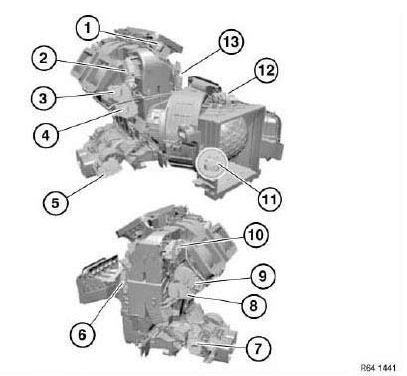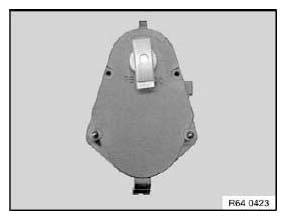BMW X5: Overview Of Heater/Air Conditioner Servomotors
BMW X5 (G05) 2019-2025 Service & Repair Manual / Heating And Air Conditioning / Heater With Operation / Overview Of Heater/Air Conditioner Servomotors

Fig. 1: Identifying Heater/Air Conditioner Servomotors Components Location
- Servomotor, defrosting
- Servomotor, footwell, rear cabin right
- Servomotor, ventilation, front right
- Servomotor, stratification, front right
- Servomotor, stratification/shut-off, rear cabin, right
- Servomotor, footwell, front left
- Servomotor, stratification, rear cabin, left/right
- Servomotor, stratification, front left/right
- Servomotor, ventilation, front left/right
- Servomotor, footwell, rear cabin, left
- Servomotor, dynamic pressure compensation
- Servomotor, fresh air/recirculated air
- Servomotor, footwell, front left/right
INSTALLING SERVODRIVE
Installation:
If necessary, align shaft of flap(s) to be actuated to position of servodrive to be installed.

Fig. 2: Identifying Servodrive Installation Position
READ NEXT:
 Removing And Installing/Replacing Heater
Removing And Installing/Replacing Heater
WARNING: Avoid contact with refrigerant and refrigerant oil.
Follow safety instructions for handling refrigerant R 134a.
Follow safety instructions for handling refrigerant oil.
IMPORTANT: Risk of d
 Removing And Installing/Replacing Heater/Air Conditioner Fan
Removing And Installing/Replacing Heater/Air Conditioner Fan
Necessary preliminary tasks:
Disconnect battery negative lead.
Remove lower trim from instrument panel.
Release screws (1).
Fig. 10: Identifying Heater/Air Conditioner Fan Screws
Release screws
 Replacing Water Valve For Heater
Replacing Water Valve For Heater
WARNING: Scalding hazard!
Work on the cooling system may only be carried out when it has cooled
down.
Follow instructions for working on cooling system!
NOTE: Disconnect coolant hoses on water valve.
SEE MORE:
 Alternator With Drive And Mount
Alternator With Drive And Mount
REPLACING ALTERNATOR BELT PULLEY
Special tools required:
12 7 110
Remove and install alternator drive belt.
Depending on alternator type, grip shaft with:
hexagon socket
multi-tooth socket or
Torx socket wrench
Release nut with special tool 12 7 110.
Installation:
Tightening torque, 12 31 2
 Replacing A Runflat Tire
Replacing A Runflat Tire
Special tools required:
36 1 091
36 1 092
36 1 093
36 1 094
36 1 095
36 1 098
Follow the fitting machine manufacturer's operating instructions.
It is absolutely essential to ensure that the equipment is in proper working
condition and that there is no damage
to the disc wheel and tire.
Af
© 2019-2025 Copyright www.bmwx5info.com

